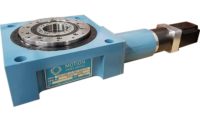In the world of wire processing equipment, applicators are like offensive linemen on a football team. They’re the unsung heroes that perform in the trenches out of the limelight. Applicators don’t get the same buzz and attention as laser wire marking or stripping machines, just like linemen are often overlooked in favor of quarterbacks or running backs.
Crimping presses haven’t changed much in recent years. But the tooling—that’s another story. Today, there are applicators equipped with RFID chips that store and relay setup and maintenance information. There are flexible applicators with multiple feed options. There are applicators with built-in cameras to aid setup. There’s even an applicator made from composite material.
Applicators are used to ensure quality and consistency in wire processing applications. They eliminate many problems that can arise from manual placement, since terminals are automatically fed into position. Machine termination also ensures a complete cycle. In addition, crimp quality monitoring systems can be employed to ensure consistency and identify quality issues.
Wire harness shops typically move from hand- or loose-piece crimping to applicators when they have high volumes. “While all crimp tools are designed to give repeatable results, crimping applicators will give the best throughput when used in a bench crimping press,” says Rob Boyd, senior product manager at Schleuniger Inc. “This becomes even more true if used in an automatic machine.”
“The two biggest benefits of using an applicator are higher production rates and consistency,” adds Robert Grenke, global product manager for application tooling at Molex Inc. “While many variables impact crimping, such as terminal, wire and operator skill, an applicator will generate higher production over a hand tool.
“A general rule of thumb is that a hand tool might be able to achieve 80 to 100 terminations per hour,” Grenke points out. “But, an applicator can [produce] between 2,000 and 8,000 terminations per hour.”
Applicators provide a more consistent, higher quality termination for one basic reason. Because the terminals are automatically brought into the crimp termination area, they are in the same position more consistently than manually loading a terminal into the crimping area. Different operators have different skill levels when it comes to inserting terminals. Indeed, placement can vary even with a single, skilled operator, due to fatigue or inattention.
Mechanical and pneumatic applicators are used for a variety of wire crimping applications. Applicators are also available with end-feed and side-feed options. The type of machine used varies by industry and size of operation.
“[Automotive suppliers want] a high-quality applicator that provides best crimp form monitoring results for a given application,” says Boyd. “Cost and lead time, of course, are always a large factor, but not as important as quality. Nonautomotive companies are [typically] looking for the lowest price applicator at the fastest lead time.”
“Small- to mid-sized contract manufacturers want a basic tool that is easy to adjust, easy to change over and easy to maintain, at a low cost,” says Grenke. “[That’s because] contract manufacturers [tend to] have a high turnover rate. The more basic a tool is, less skill sets are required to run and maintain the applicator by new operators.
“[Small- to mid-sized wire harness shops] know that as long as they follow the proper crimping and maintenance guidelines used in the industry for more than 30 years, they can still achieve a high quality termination without the added costs of high-end features they don’t need,” notes Grenke.
“In many cases, large harness shops and specialized industries, like automotive, aerospace, military and medical, are required to have all of the features available for an applicator, because OEMs [and regulators] demand it,” Grenke points out. “[They invest] in automated operations as a way to maintain information flow and believe the extra features provide benefits that outweigh the increased costs.”
New vs. Old Technology
Applicator technology has changed quite a bit in the last decade. “RFID chips are a big change for service purposes,” says Boyd. “Another change is the introduction of motorized feed systems for precision and application flexibility, which is a big trend in applicators right now.
“Another [trend] that has had an effect is smaller tooling cassettes that are easily exchanged from a main body for faster changeover and better applicator flexibility,” adds Boyd. “It’s all about being as efficient as possible.”
Schleuniger’s newest applicator is the Uni-G, a pneumatic feed device for a variety of wire processing applications. “Many accessories, such as wire funnels, wire hold-downs and terminal ejectors, make the Uni-G a very versatile applicator,” claims Boyd.
Up until the mid-1990s, applicator technology was fairly consistent. The heavy-duty mini frame was the industry standard, and virtually all applicator manufacturers used a similar looking frame that was made from castings, then machined and ground to dimensions.
“With today’s [advanced] metal-working technologies, we are able to take better advantage of improved tolerances, materials and processes to produce a much better applicator,” claims Kevin Adler, director of new business development for applicators, terminators and hand tools at TE Connectivity. “The clearance between the ram and the housing is important, because too much slop can lead to excessive wear, which can translate to crimper or anvil wear and false readings on a crimp quality monitor.”
Another recent development is the average size of terminals being crimped. “Ten years ago, most terminals were being crimped onto wires ranging in size from 14 to 20 AWG,” says Adler. “This has definitely shifted, as customers are generally running either large wires (power) or small wires (signal). It is quite common to see terminals as small as 28 to 32 AWG.”
In addition, some terminals are now limited by the wire ranges that can be accepted. “For example, in the past, some wire barrels were designed for three, and sometimes even four, different wire sizes,” Adler points out. “However, crimping at extreme conditions can lead to cross sections that are not acceptable.
“The result is more specialized crimping parameters within the tooling to deliver the requested profile and cross section,” explains Adler. “It is becoming more common to see wire barrels restricted to two or even one wire size.”
Aligning small wires and terminals today can be challenging and time consuming. That’s why TE Connectivity recently unveiled a vision system called EYE Check. The camera and software aid in applicator feed set up and terminal alignment to help eliminate errors.
“The camera magnifies the crimp area to allow for precise feed alignment of the centerline of the terminal to the anvil, which helps to reduce bending, rolling and asymmetrical crimps,” claims Adler.
While new product features often have benefits, some can have downsides. “For instance, RFID chips can help a company track its assets more easily and accurately than maintaining a log book for each applicator,” says Grenke. “However, it does add cost and can increase the skill set required by operators or managers.
“Built-in cameras help operators see what is actually happening during the crimp cycle,” adds Grenke. “However, these are only useful if operators have in-depth knowledge of the applicator so that they can understand what is being shown in the terminal after the crimp cycle is performed. These [devices] can be very expensive and require more advanced skills.
“Flexible applicator designs are beneficial in that they allow [tools] to be modified for terminating a different terminal number with just a few changes to parts,” explains Grenke. “This eliminates the need to purchase or lease a new tool, which can actually present a cost savings.”
Molex continues to see big demand for its FineAdjust applicator, which was unveiled about 15 years ago. “This tried-and-true tool is designed to provide an effective method of applying a wide range of feed terminals to prestripped wire and cable,” says Grenke. “It offers minimal setup time, versatility and reliability, and is designed for mid- to high-volume production. It also allows customers to make incremental changes with the cam adjustments to allow the operator to hit the crimp and insulation height targets almost to the mean of the critical specification.”
Composite or Metal?
Earlier this year, ETCO Inc. unveiled a lightweight applicator made from composite materials. Unlike traditional metal applicators, the EDGE-C features a unibody construction. The molded frame offers durability and reliability advantages.
“It functions the same as heavier metal-based applicators, but costs less and can be manufactured quicker to reduce lead time,” claims Cris Gravel, applicator engineer at ETCO. “The long-term ownership cost of the composite applicator is significantly less than traditional metal applicator housings.”
According to Gravel, it also provides superior lubricity and tolerances. That allows engineers to operate the applicator for longer periods of time before having to lube parts. When handling the composite frame, operators can perform maintenance on the applicator with little risk of injury from burns.
“The most astonishing thing to me is how little the applicator industry has changed in the last 15 to 20 years,” says Gravel. “Reliability of these products is essential, so making drastic changes means extensive testing.
“Our beta testers really felt that the [lighter] weight was a significant advantage when setting applicators into the tight confines of automated machines,” Gravel points out. “[The composite machine] does not generate heat from friction like all metal applicators. This is particularly noticeable in today’s machines capable of high production rates. And, the natural lubricity of the material will continue to run if lubrication or maintenance is neglected.
“Our in-house testing showed absolutely no signs of wear in the frame after millions of cycles,” claims Gravel. “Destructive testing showed the composite frame [to be] extremely tough.” It would stand up better than similarly designed cast units.”
TE Connectivity’s newest innovation is the OCEAN applicator. According to Adler, it has “some of the tightest tolerances in the industry. And, we’re seeing less spare parts wear as a result of the improved terminal feeding and general applicator tolerances.
“The position of the terminal over the anvil ensures a good crimp and our [product] has been designed and tested to produce superior results,” claims Adler. “In addition, we have greatly simplified the adjustment features.”
ASSEMBLY ONLINE
For more profiles of cable and wire harness manufacturers, visit www.assemblymag.com to read these articles:










